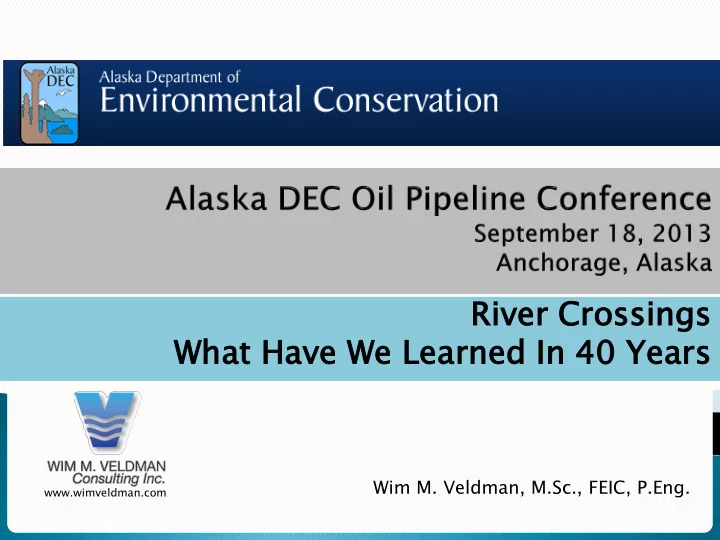

Rive iver C r Cro ross ssings What at Have ave W We Le Lear arned I In 4 40 Ye Year ars Wim M. Veldman, M.Sc., FEIC, P.Eng. www.wimveldman.com
DESIGN CONSTRUCTION OPERATIONS 2
SO WHAT? ◦ Interesting? Does it matter? WHAT IF? ◦ We will never know everything ◦ Thus how do we ensure acceptable risks 3
FLOW ◦ Water Level Scour = Pipe Depth SCOUR ◦ Bank Erosion Floodplain Changes = Crossing Extent 4
Limited/no data north of Brooks Range ◦ Used very conservative rainfall/runoff model ◦ BUT, 1992 flood >> design flow FLOW OW - NOW OW 35 – 40 years of data north of Brooks Range ◦ Adequate for flood frequency analysis Unique conditions ◦ Influence of lakes/wetlands. “Release” of outlets in spring ◦ Ice jam releases – up to 5X peak flow possible ◦ Glacier dammed lake releases 5
History of releases? Flow data? Triggered by: ◦ Snow melt (typical) ◦ And/or heavy rain (Tazlina R, 1997) ◦ Neither – some mid-winter releases (Tazlina R, 2005) Tazlina River 6
What if/Impact? ◦ Buried crossing ◦ Elevated crossing ◦ River training structures ◦ 1997 Tazlina River Flood greater than design 7
Summer floods ◦ Same as non-arctic rivers Spring floods ◦ Flow over ground - fast icings ◦ Ice jams/jam releases 8
General theory = ◦ Cold + Low Snow = maximum icings But site specifically, the opposite can occur ◦ 1975 Dietrich River, cold, low snow = maximum icing at MP197 = long dike required to protect TAPS ◦ 1976 Dietrich River, warm, high snow = maximum icing one mile downstream = flooding of the Dietrich camp. 9
Impact of aufeis (icing) levels on: ◦ Buried crossings – minimal ◦ Elevated line/crossings – could be significant ◦ River training structures – could be significant Terraces can limit maximum icing levels Flow downcuts through icings or deteriorates the ice in 3-5 days. 10
General ◦ straight channel scour during floods ◦ usually not significant if stream is in “regime” Local scour ◦ At bends, confluences, debris jams and structures ◦ 1.5 to 3.5 x general scour depth 11
General Scour ◦ Regime ◦ Competent Velocity ◦ Mathematical Models Local Scour ◦ Present and future channel conditions ◦ Qualitative/empirical data SO WHAT ? ◦ General scour not significant generally ◦ Local scour much more significant ◦ Is pipeline exposure = failure? 12
Spring ◦ Over ice/frozen ground ◦ Minimal scour Ice jams ◦ Severe scour at jam ◦ Scour during jam release Alluvial fans/debris flows ◦ Deposition ◦ Channel changes Mackenzie River Delta ◦ Hydraulic/thermal conditions 13
Summer Floods ◦ Same as non-arctic rivers ◦ Survey historic erosion during major floods. Use this as a “trigger” to determine when bank protection is required for operating lines. ◦ Bank erosion, especially in treed areas which generate debris, is a prime threat to buried pipelines Spring Floods ◦ Frozen/snow covered banks = little bank erosion ◦ Overflows in floodplains = little scour or channel changes in the floodplain. Structures can be affected. 14
Caused primarily by: ◦ High floods = sediment movement = debris = channel changes = bank erosion ◦ All things being equal, less changes on Arctic rivers especially those north of the Brooks Range 15
Quantitative vs. Qualitative Analysis 16
17
Various techniques for: ◦ Environmental reasons ◦ Construction reasons Arctic construction – hot oil pipelines ◦ A “dry” frozen ditch is not necessarily optimum ◦ Impact of icings on feasible flow isolation methods 18
Open cut, wet ditch. Frozen “dry” ditch Flow Isolation-Pumping Flow Isolation- Pipe Flume 19
Open Cut – Sauerman Dragline HDD Bore Flow Isolation - Superflumes 20
Free span of pipe Pile Supports Suspension Bridge Girder Bridge 21
Extreme event - 2006 Impact on: ◦ Access roads and highways ◦ Buried pipeline ◦ Elevated pipeline Consequences of impact ◦ Access ◦ Integrity ◦ Rebuild or upgrade 22
Adapt to Conditions 23
Schedule for Conditions 24
Challenge Conventional Design Wisdom 25
Challenge Conventional Regulatory Wisdom “Do You Know What Tsina River Means ” 26
Understand Scope of Commitment 27
Utilize Operational Performance Data 28
Value of Hands-On Knowledge 29
Utilize Local Knowledge 30
31
Recommend
More recommend